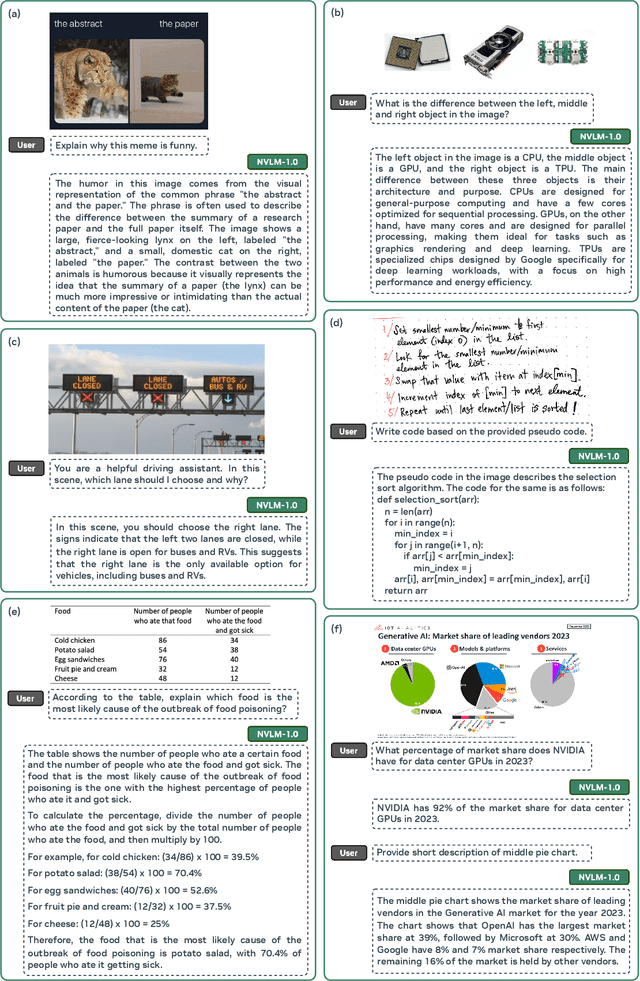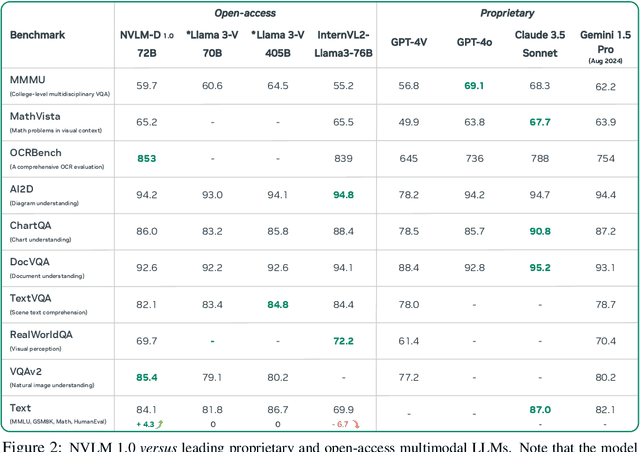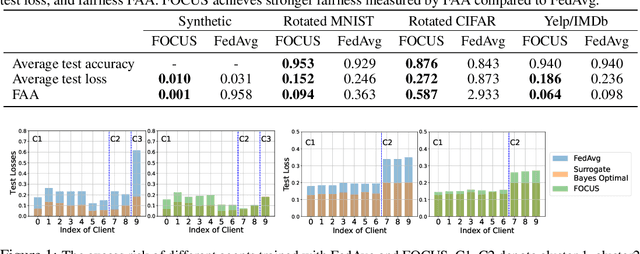Boxin Wang
Nemotron-H: A Family of Accurate and Efficient Hybrid Mamba-Transformer Models
Apr 10, 2025Abstract:As inference-time scaling becomes critical for enhanced reasoning capabilities, it is increasingly becoming important to build models that are efficient to infer. We introduce Nemotron-H, a family of 8B and 56B/47B hybrid Mamba-Transformer models designed to reduce inference cost for a given accuracy level. To achieve this goal, we replace the majority of self-attention layers in the common Transformer model architecture with Mamba layers that perform constant computation and require constant memory per generated token. We show that Nemotron-H models offer either better or on-par accuracy compared to other similarly-sized state-of-the-art open-sourced Transformer models (e.g., Qwen-2.5-7B/72B and Llama-3.1-8B/70B), while being up to 3$\times$ faster at inference. To further increase inference speed and reduce the memory required at inference time, we created Nemotron-H-47B-Base from the 56B model using a new compression via pruning and distillation technique called MiniPuzzle. Nemotron-H-47B-Base achieves similar accuracy to the 56B model, but is 20% faster to infer. In addition, we introduce an FP8-based training recipe and show that it can achieve on par results with BF16-based training. This recipe is used to train the 56B model. All Nemotron-H models will be released, with support in Hugging Face, NeMo, and Megatron-LM.
From 128K to 4M: Efficient Training of Ultra-Long Context Large Language Models
Apr 08, 2025Abstract:Long-context capabilities are essential for a wide range of applications, including document and video understanding, in-context learning, and inference-time scaling, all of which require models to process and reason over long sequences of text and multimodal data. In this work, we introduce a efficient training recipe for building ultra-long context LLMs from aligned instruct model, pushing the boundaries of context lengths from 128K to 1M, 2M, and 4M tokens. Our approach leverages efficient continued pretraining strategies to extend the context window and employs effective instruction tuning to maintain the instruction-following and reasoning abilities. Our UltraLong-8B, built on Llama3.1-Instruct with our recipe, achieves state-of-the-art performance across a diverse set of long-context benchmarks. Importantly, models trained with our approach maintain competitive performance on standard benchmarks, demonstrating balanced improvements for both long and short context tasks. We further provide an in-depth analysis of key design choices, highlighting the impacts of scaling strategies and data composition. Our findings establish a robust framework for efficiently scaling context lengths while preserving general model capabilities. We release all model weights at: https://ultralong.github.io/.
Cosmos-Reason1: From Physical Common Sense To Embodied Reasoning
Mar 18, 2025Abstract:Physical AI systems need to perceive, understand, and perform complex actions in the physical world. In this paper, we present the Cosmos-Reason1 models that can understand the physical world and generate appropriate embodied decisions (e.g., next step action) in natural language through long chain-of-thought reasoning processes. We begin by defining key capabilities for Physical AI reasoning, with a focus on physical common sense and embodied reasoning. To represent physical common sense, we use a hierarchical ontology that captures fundamental knowledge about space, time, and physics. For embodied reasoning, we rely on a two-dimensional ontology that generalizes across different physical embodiments. Building on these capabilities, we develop two multimodal large language models, Cosmos-Reason1-8B and Cosmos-Reason1-56B. We curate data and train our models in four stages: vision pre-training, general supervised fine-tuning (SFT), Physical AI SFT, and Physical AI reinforcement learning (RL) as the post-training. To evaluate our models, we build comprehensive benchmarks for physical common sense and embodied reasoning according to our ontologies. Evaluation results show that Physical AI SFT and reinforcement learning bring significant improvements. To facilitate the development of Physical AI, we will make our code and pre-trained models available under the NVIDIA Open Model License at https://github.com/nvidia-cosmos/cosmos-reason1.
NVLM: Open Frontier-Class Multimodal LLMs
Sep 17, 2024



Abstract:We introduce NVLM 1.0, a family of frontier-class multimodal large language models (LLMs) that achieve state-of-the-art results on vision-language tasks, rivaling the leading proprietary models (e.g., GPT-4o) and open-access models (e.g., Llama 3-V 405B and InternVL 2). Remarkably, NVLM 1.0 shows improved text-only performance over its LLM backbone after multimodal training. In terms of model design, we perform a comprehensive comparison between decoder-only multimodal LLMs (e.g., LLaVA) and cross-attention-based models (e.g., Flamingo). Based on the strengths and weaknesses of both approaches, we propose a novel architecture that enhances both training efficiency and multimodal reasoning capabilities. Furthermore, we introduce a 1-D tile-tagging design for tile-based dynamic high-resolution images, which significantly boosts performance on multimodal reasoning and OCR-related tasks. Regarding training data, we meticulously curate and provide detailed information on our multimodal pretraining and supervised fine-tuning datasets. Our findings indicate that dataset quality and task diversity are more important than scale, even during the pretraining phase, across all architectures. Notably, we develop production-grade multimodality for the NVLM-1.0 models, enabling them to excel in vision-language tasks while maintaining and even improving text-only performance compared to their LLM backbones. To achieve this, we craft and integrate a high-quality text-only dataset into multimodal training, alongside a substantial amount of multimodal math and reasoning data, leading to enhanced math and coding capabilities across modalities. To advance research in the field, we are releasing the model weights and will open-source the code for the community: https://nvlm-project.github.io/.
RankRAG: Unifying Context Ranking with Retrieval-Augmented Generation in LLMs
Jul 02, 2024



Abstract:Large language models (LLMs) typically utilize the top-k contexts from a retriever in retrieval-augmented generation (RAG). In this work, we propose a novel instruction fine-tuning framework RankRAG, which instruction-tunes a single LLM for the dual purpose of context ranking and answer generation in RAG. In particular, the instruction-tuned LLMs work surprisingly well by adding a small fraction of ranking data into the training blend, and outperform existing expert ranking models, including the same LLM exclusively fine-tuned on a large amount of ranking data. For generation, we compare our model with many strong baselines, including GPT-4-0613, GPT-4-turbo-2024-0409, and ChatQA-1.5, an open-sourced model with the state-of-the-art performance on RAG benchmarks. Specifically, our Llama3-RankRAG significantly outperforms Llama3-ChatQA-1.5 and GPT-4 models on nine knowledge-intensive benchmarks. In addition, it also performs comparably to GPT-4 on five RAG benchmarks in the biomedical domain without instruction fine-tuning on biomedical data, demonstrating its superb capability for generalization to new domains.
InstructRetro: Instruction Tuning post Retrieval-Augmented Pretraining
Oct 11, 2023Abstract:Pretraining auto-regressive large language models (LLMs) with retrieval demonstrates better perplexity and factual accuracy by leveraging external databases. However, the size of existing pretrained retrieval-augmented LLM is still limited (e.g., Retro has 7.5B parameters), which limits the effectiveness of instruction tuning and zero-shot generalization. In this work, we introduce Retro 48B, the largest LLM pretrained with retrieval before instruction tuning. Specifically, we continue to pretrain the 43B GPT model on additional 100 billion tokens using the Retro augmentation method by retrieving from 1.2 trillion tokens. The obtained foundation model, Retro 48B, largely outperforms the original 43B GPT in terms of perplexity. After instruction tuning on Retro, InstructRetro demonstrates significant improvement over the instruction tuned GPT on zero-shot question answering (QA) tasks. Specifically, the average improvement of InstructRetro is 7% over its GPT counterpart across 8 short-form QA tasks, and 10% over GPT across 4 challenging long-form QA tasks. Surprisingly, we find that one can ablate the encoder from InstructRetro architecture and directly use its decoder backbone, while achieving comparable results. We hypothesize that pretraining with retrieval makes its decoder good at incorporating context for QA. Our results highlights the promising direction to obtain a better GPT decoder for QA through continued pretraining with retrieval before instruction tuning.
DecodingTrust: A Comprehensive Assessment of Trustworthiness in GPT Models
Jun 20, 2023Abstract:Generative Pre-trained Transformer (GPT) models have exhibited exciting progress in capabilities, capturing the interest of practitioners and the public alike. Yet, while the literature on the trustworthiness of GPT models remains limited, practitioners have proposed employing capable GPT models for sensitive applications to healthcare and finance - where mistakes can be costly. To this end, this work proposes a comprehensive trustworthiness evaluation for large language models with a focus on GPT-4 and GPT-3.5, considering diverse perspectives - including toxicity, stereotype bias, adversarial robustness, out-of-distribution robustness, robustness on adversarial demonstrations, privacy, machine ethics, and fairness. Based on our evaluations, we discover previously unpublished vulnerabilities to trustworthiness threats. For instance, we find that GPT models can be easily misled to generate toxic and biased outputs and leak private information in both training data and conversation history. We also find that although GPT-4 is usually more trustworthy than GPT-3.5 on standard benchmarks, GPT-4 is more vulnerable given jailbreaking system or user prompts, potentially due to the reason that GPT-4 follows the (misleading) instructions more precisely. Our work illustrates a comprehensive trustworthiness evaluation of GPT models and sheds light on the trustworthiness gaps. Our benchmark is publicly available at https://decodingtrust.github.io/.
Can Public Large Language Models Help Private Cross-device Federated Learning?
May 20, 2023Abstract:We study (differentially) private federated learning (FL) of language models. The language models in cross-device FL are relatively small, which can be trained with meaningful formal user-level differential privacy (DP) guarantees when massive parallelism in training is enabled by the participation of a moderate size of users. Recently, public data has been used to improve privacy-utility trade-offs for both large and small language models. In this work, we provide a systematic study of using large-scale public data and LLMs to help differentially private training of on-device FL models, and further improve the privacy-utility tradeoff by techniques of distillation. Moreover, we propose a novel distribution matching algorithm with theoretical grounding to sample public data close to private data distribution, which significantly improves the sample efficiency of (pre-)training on public data. The proposed method is efficient and effective for training private model by taking advantage of public data, especially for customized on-device architectures that do not have ready-to-use pre-trained models.
Shall We Pretrain Autoregressive Language Models with Retrieval? A Comprehensive Study
Apr 13, 2023



Abstract:Large decoder-only language models (LMs) can be largely improved in terms of perplexity by retrieval (e.g., RETRO), but its impact on text generation quality and downstream task accuracy is unclear. Thus, it is still an open question: shall we pretrain large autoregressive LMs with retrieval? To answer it, we perform a comprehensive study on a scalable pre-trained retrieval-augmented LM (i.e., RETRO) compared with standard GPT and retrieval-augmented GPT incorporated at fine-tuning or inference stages. We first provide the recipe to reproduce RETRO up to 9.5B parameters while retrieving a text corpus with 330B tokens. Based on that, we have the following novel findings: i) RETRO outperforms GPT on text generation with much less degeneration (i.e., repetition), moderately higher factual accuracy, and slightly lower toxicity with a nontoxic retrieval database. ii) On the LM Evaluation Harness benchmark, RETRO largely outperforms GPT on knowledge-intensive tasks, but is on par with GPT on other tasks. Furthermore, we introduce a simple variant of the model, RETRO++, which largely improves open-domain QA results of original RETRO (e.g., EM score +8.6 on Natural Question) and significantly outperforms retrieval-augmented GPT across different model sizes. Our findings highlight the promising direction of pretraining autoregressive LMs with retrieval as future foundation models. We release our implementation at: https://github.com/NVIDIA/Megatron-LM#retro
FOCUS: Fairness via Agent-Awareness for Federated Learning on Heterogeneous Data
Jul 21, 2022

Abstract:Federated learning (FL) provides an effective paradigm to train machine learning models over distributed data with privacy protection. However, recent studies show that FL is subject to various security, privacy, and fairness threats due to the potentially malicious and heterogeneous local agents. For instance, it is vulnerable to local adversarial agents who only contribute low-quality data, with the goal of harming the performance of those with high-quality data. This kind of attack hence breaks existing definitions of fairness in FL that mainly focus on a certain notion of performance parity. In this work, we aim to address this limitation and propose a formal definition of fairness via agent-awareness for FL (FAA), which takes the heterogeneous data contributions of local agents into account. In addition, we propose a fair FL training algorithm based on agent clustering (FOCUS) to achieve FAA. Theoretically, we prove the convergence and optimality of FOCUS under mild conditions for linear models and general convex loss functions with bounded smoothness. We also prove that FOCUS always achieves higher fairness measured by FAA compared with standard FedAvg protocol under both linear models and general convex loss functions. Empirically, we evaluate FOCUS on four datasets, including synthetic data, images, and texts under different settings, and we show that FOCUS achieves significantly higher fairness based on FAA while maintaining similar or even higher prediction accuracy compared with FedAvg.
 Add to Chrome
Add to Chrome Add to Firefox
Add to Firefox Add to Edge
Add to Edge